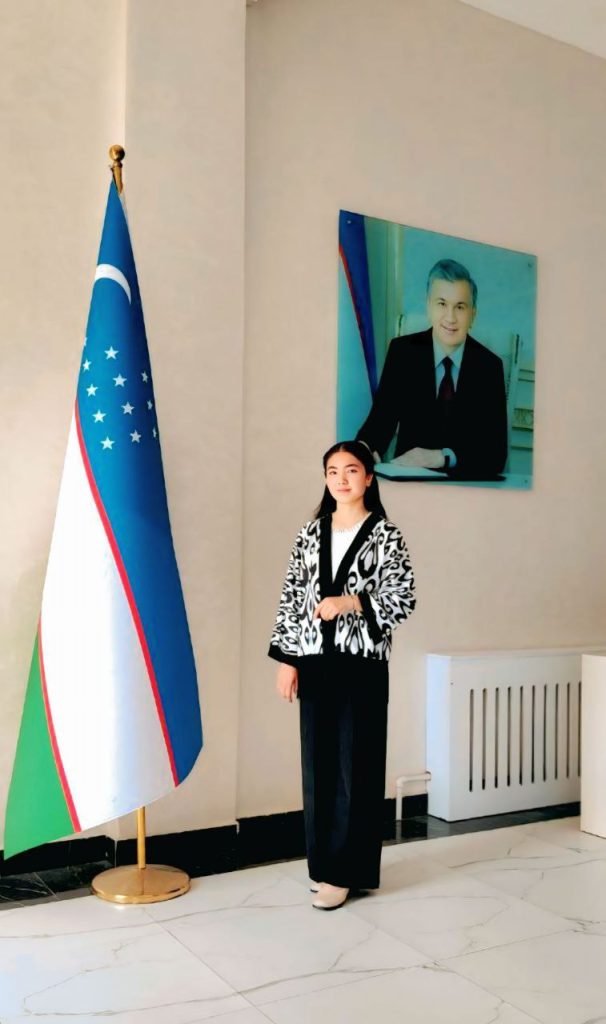(No title yet)
There was no door she opened only a thought. And suddenly, she was there, in the city no one ever comes from.
Maya had no idea how she had arrived. There was no bus, no train, no discernible route from past to present. She remembered only the urge to run from what she did not understand, and from those who did not understand her. Everything around her seemed to continue, to move forward, while she remained still suspended in a reality that felt either irrelevant or unreadable.
And then, there was nothing. No sound, no wind, no weight. Only a void that refused to let her forget. Her breath did not feel like her own. The city was unreal or perhaps she was. She felt no hands, no feet, only the aching distance between what had been lost and the emptiness that had taken its place.
Maya looked around: streets that led nowhere, houses that seemed to breathe. Everything blurred mist-wrapped, undefined, refusing form. The sky bore no color, or at least none she could name, yet it folded around her like an invisible presence. The city was full of people nor rather, figures. Shapes that drifted through the streets, faceless, yet moving as though they remembered being human. And Maya, caught in her paralysis, seemed to mirror their strange stillness. But she was not one of them. Not really.
She stepped into a street, her feet gliding over the soft ground, which gave no sound in return. She looked up at the buildings or were they houses? Everything was in motion, yet the shapes refused to settle into anything familiar. The city itself shifted with every step, every thought. And yet, it always remained the same: a grey swirl that promised nothing but the quiet ache of loss.
It wasn’t the first time she had been here, she realized just as she caught sight of a woman in the distance. Maya understood, without knowing how, that the woman had been waiting for her. The woman had no face or perhaps it was that her face always slipped away, dissolving into the air itself. Maya stood still, her gaze fixed on the woman. There was something about her, something that struck a chord deep within, though she couldn’t say why.
She wanted to speak, to ask something but her voice was gone, like an echo you can’t catch, like sound turned inward. The woman looked at Maya or rather, seemed to look through her, as if Maya were not really there. It wasn’t coldness, nor absence, it was something else. A kind of stillness that held everything. A silence that embraced.
“Where am I?” Maya asked at last, the words dragging from her mouth with great effort. Her voice sounded hollow in the space, so hollow that it startled even her. The woman smiled, though it was not a smile meant to comfort. “You’re simply here,” she said. “Where you don’t belong, but cannot leave.” Maya wanted to ask her something else, but a strange sensation overtook her. She couldn’t quite name it, but it felt as though the question itself had slipped away. Or perhaps it had always been lost, long before she stepped into the city.
“Am I dead?” Maya asked.
The woman shook her head.
“You’re alive, but not truly here. This is the city where the living and the dead never meet. Where you arrive when you’ve lost your grip on reality.” She paused. “You are at the edge of the world. At the edge of what’s real”.
Maya felt her heart begin to race. Was this real? Was this all that remained? The woman looked at her like a mirror, her eyes reflecting everything Maya wished she had never lived through.
Stretching between them like a string that may break if one of them breathed too loudly, the quiet was tense. Maya looked over her shoulder, wishing to see a doorway, a street, some remnant of the life she knew, but she saw nothing. All she could see was a huge, moving cloud that pulsed like thinking, retreating anytime she attempted to concentrate on it. The ground underneath her didn’t feel steady or strong, but soft, like standing on a vague memory. She moved ahead cautiously one step a time, as if walking might help her remember where she was. There were tiny murmurs in the air, more like incomplete phrases circling in search of someone who could still listen. She believed they were calling her name, but every time she tried to hold the sound, it vanished. Maya realized for the first time that she might not be following the lady at all, but rather that she might be going into the shape of her own absence, as the woman remained.
Longing
The sky is not breath,
but the trace of somewhere I once belonged.
The city is not a street,
but a path I’ve long forgotten.
Where am I, and where are you,
if home is never a place we reach together,
Grief is the presence of what shaped me,
but also the absence of what can never be.
What I seek I cannot find,
because it is not the city,
This place reflects quietly who I’ve become,
In the absence of what held me.
“How can I leave?” she asked finally.
The woman ignored her. “That depends”
“On what?”
“On wheter you still believe that you must.”
Maya parted her lips, then shut them again. The response didn’t feel incorrect, but it also didn’t make sense. There was a long pause, that neither of them filled. Maya started to notice that you weren’t rushed here. The things you often tried to outrun were able to sit with you.
She looked at her feet. They were bare, though she didn’t remove her shoes. The ground felt soft, like walking on recollection. Something behind her echoed, it might have been laughter, it might have been nothing.
“What if I spend too much time here? Maya enquired.
The lady cocked her head. “Nothing. That’s the danger.”
A bird flew overhead, or she believed it was. It had too many wings, Maya’s gaze was unable to focus on it. Her looks might be deceiving. It disappeared before she knew for sure.
“I’m not sure how to return” Maya remarked.
“You will.”
“And if I’d rather not?”
“Then you’ll remain. Until it becomes too much.”
She looked up at the anonymous woman. “Have you spent much time here?”
The woman didn’ respond.
A City Without Maps
I walk without knowing
Unsure if I’ve just wandered here
Or simply drifted here.
Nothing happens,
Everything waits.
Time loses its manners.
Doors open without hinges.
Shadows emerge.
Before the light knows why.
What’s the search?
The city keeps showing me
things I nearly recall.
That’s plenty for now.
Maya didn’t really follow the woman as she kept walking next to her, unsure if they were actually going forward or just repeatedly going around the same area of the city.
Every now and then, they went by someone, a blur of a person, drifting by with their eyes obscured or perhaps not there. Nobody said anything or made contact. There was too much silence in the air surrounding them for sound to seem normal. There was light even though there was no sun. It was all dark yet discernible.
Maya was unsure of her feelings. She kept expecting to feel panicked, afraid, or even sad, but she didn’t. Everything felt muted, as if her emotions had chosen to take a break while the rest of her continued to move.
“Do people live here?” She asked eventually, breaking the silence.
“No” the woman said. “They wait.”
“For what purpose?”
“To remember who they are. Or forget why they came.”
Maya scowled. “That sounds passive.”
The woman gave a nod, nearly grinning. “That is grief.”
The walls leaned too closely together as they turned down a tight lane. Maya sensed the breathing of the bricks, as though the city itself was dreaming while it slept. A flicker, a slow flash of something like lightning but without thunder, was visible somewhere above them. The sky rippled as she peered up.
Maya slowed. “I feel as though the city is observing me”.
“It is.”
“But only because it remembers what you don’t”.
Maya wasn’t sure what that meant, and didn’t ask.
There was a dim glow behind the glass of a window they passed. A figure inside stood motionless, gazing at nothing. A plate, a fork, and a glass of water are on the table next to them. Untouched.
Maya gazed for a while. “That looks like.. .”
She stopped herself.
The alley eventually led to a larger area that wasn’t exactly a square or courtyard. It was nameless. A fountain stood in the center, dry, yet the sound of water was audible.
Maya took a seat at the edge. Even though she hadn’t realised it yet, her legs were beginning to hurt.
She whispered, “did I bring this place with me? Or has it arrived already?”
The woman sitting next to her answered, “both, this city doesn’t build itself. It reflects.”
Maya tried to examine the woman’s face once again, but it kept slipping. The hint of a smile. A crease that might have been a scar. Or a shadow. Or a trick of the light.
She questioned, “why can’t I remember?”
“You do, but not all at once.”
They spend some time there.
Maya observed a partially formed cat moving across the stones. With every stride it wavered, as though it wasn’t sure it wanted to be there. Nevertheless, it walked. Determined.
She became strangely emotional over it. She refrained from crying. It didn’t seem permitted by the city. But her chest began to feel heavy. Not crushing, just a heavines she was unaware off.
A few figures went by them. One of them paused and glanced at Maya, so it looked. The figure then continued to move. Not intentionally, just … moving
She said, “I don’t want to be one of them.”
The woman remained silent.
“Will he be here? Maya asked, without glancing at the woman. Her voice gently rose above the wind.
Maya thought she hadnt heard the woman, since she was silent for so long.
“You might see the shape of what you miss, but not the person.”
“Why not?”
“Because he isnt here, just what you remember about him.”
“That’s unfair”
“No.” The woman said softly? “It isnt.”
Once more, they walked.
The city opened into a park. The trees had pale, drooping leaves that resembled coiled papers. Not a bird no breeze. All that was waiting was the soft hum.
Maya sat again, by a bench near one of the trees. Her body had become calm, as if it wanted to do nothing except remain motionless, but she didn’t feel exhausted.
The woman stood a couple of feet away.
Maya studied her hands. The outlines of her scars were visible. The ones she recognized from childhood scrapes, one from a cabinet corner, and one from something she couldn’t even recall. She still had them. Her body seemed to remember all her head had forgotten.
Maya closed her eyes and layed back on the bench.
She felt still inside, for the first time since arriving.
Auto pilot
I didn’t come here seeking healing,
Or closure,
Or acceptance.
Just arrived
Where I miss you
after the world turned sideways.
This is not a place,
It’s a moment between pain and comprehension,
A pause.
The day, or what passed for it here, deepened into a sort of dark gloom, and the air became heavier. With windows that flickered like half remembered eyes, the buildings leaned closer. Faint chimes might be heard somewhere in the distance, the sound of a clockstriking an imaginary hour that never happened.
Maya, not sure why, stood up. Already, the woman was moving. Her motion was more like the drifting of fog. Maya trailed faster, but every step seemed like a silent rewriting of herself. The streets grew narrower, doors ermerging where walls had been, each with symbols that disappeared is she stared too long.
The air was heavy with the scent of paper, rain and something metallic. Now the city seemed older, weary or overly nostalgic. At that moment, Maya saw a door standing where no building should, with a faint blue glimmer in the distance. The structure had no windows, just a door. She wasn’t sure why but felt drawn to it. She stretched out her hand for the handle, but hesitated when her fingers touched the cold doorknob, pausing a few seconds to see if she felt panicked but the only thing she felt was wonder.
She pulled the door open.
Inside, there was more room than she had anticipated. There was a high ceiling, wooden floors, the smell of old paper lingered and what smelled like coffee, although there was no cup in sight. File cabinets were arranged in endless rows along the walls. Every drawer had a label with a name that vanished as soon as she attempted to read it. A table in the center of the space caught her attention. There lay an unopened letter on it. No name. No adress.
She remained still. Something delicate and serene hung in the air of this place. As though one had to be very adept at being silent to be in this place. She ran her hand over the envelope. Nothing happened. She didn’t open it even though she wanted to. Maya flinched, the woman was suddenly behind her. She seemed to have heard her thoughts when she said, “you don’t have to know everything.”
“But I would like to,” Maya replied quietly.
“And that’s the start,” the woman stated. “But not of responses. Of inquiries you can tolerate.”
Maya looked at her. “Is it awful that you don’t know who you are anymore?”
“Just if you think you ever truly did.”
The letter was left behind. Without turning around they left the building.
They walked again. It seemed different even though the scenery had barely changed. Everything felt a bit lighter, as though something had been released by the air itself.
She saw a woman who was sitting on a bench farther down, writing in a notebook. Her face was a whirl of shadow, not empty, like the moments before waking up from a dream.
She grinned as she looked up. Maya wasn’t afraid, just calm. The woman next to her remarked, “she writes what no one dares to say.”
As though she understood Maya nodded. Perhaps she did.
They eventually arrived at a gate. Open, rusty and simple. Grass beyond it, no fog, only a tree and a field. Not magnificent, not enchanted. Just a big tree.
Without being asked, Maya approached it. There was a stone underneath the tree. Her name, but in a different font, was on it. The letters seemed incomplete. She sat down on her knees and took the stone in her hands to take a closer look. And suddenly she realized that you don’t just vanish, you maintain your shape while you slowly slip away.
Falling or fading?
We don’t dissapear,
We deteriorate.
Like breath on glass,
Every layer thinner than the one before it.
Tougher to see, but still there.
More difficult to keep.
The same appearance, the same voice
Something shifts
An absence perceived.
And by the time you realize it
It has already shaped who you are.
Maya spent a long time near the tree. Weighing less than it should have, the stone lay in her palms. When she looked back down, her name had disappeared. Even the stone seemed to have forgotten, leaving only the faint impression of the letters.
There was no sign of the woman.
Maya briefly believed she heard her voice, but it was more like something grazing her mind than a sound. Not so much a message as a suggestion: It’s time to leave.
So, Maya got up, there was no breeze, but the grass swayed. The air had started to stretch into a sort of stransculent sheen. Behind her the tree leaned into as mall sigh, like an exhale.
Maya started to move, but she wasn’t sure which way she was going. Despite the lack of path, or the woman that felt like a support, her feet managed to find one.
She lost the ability to look back, which is why the field behind her appeared to fade rather than actually disappear. Quietly, the horizon curled in on itself, rewriting proximity and erasing distance. Every footfall conveyed the tiniest sound, like a heartbeat, yet left no trace. The air ahead trembled, but it was neither light nor shadow, only a shaky hint of both. It felt like the universe was starting to knit itself around her as she extended a hand and felt warmth. Walls gathered instead of rising and corners formed. Above, the sky grew thinner until it reached the ceiling. When she blinked, the field vanished and was replaced by a hallway that had always existed, only for her consciousness to catch up. She could still smell the grass somewhat on her skin, but it was now mixed with an electrifying hum of a world that had been breathed into existence, rather than constructed. It seemed thin, infinite and echoing at first, like wandering inside her own breath.
The same pattern seemed to permeate every hallway, like a whisper without a mouth or an echo without a source.
Maya did not walk to get away, but rather because the silence here made her feel as though she had to give up on something she didn’t fully comprehend. As if the world were composed of the leftovers of thought, the air had thickened into a milky delicate form of light.
She ran her hand along a wall. Warm and slightly shaking, it was like the skins surface recalling a touch. She thought she heard her name again from behind her. But here, she knew, names were pointless. They simply indicated the forms of those who had already moved on. She questioned whether this was what sadness turned into when it forgot itself, a building of unfulfilled need rather than agony or sorrow.
Every hallway was like a breath that was never entirely released. Unfinished sentences pressed into the walls, waiting for a listener who might never come, caused the air to tremor with what could have been voices. As if the labyrinth required her movement to survive, the light changed in time with her heartbeat, growing brighter when she moved ahead and diminishing when she halted. She experienced a sense of both necessity and haunting, as if walking prevented the world from falling apart.
The hallways curved gently never sharply, it wasn’t like a maze. There was a corridor or a reflection of one at each curve. There wasn’t actually a ceiling, only a slight bend in the sky that wavered when she inhaled too deeply.
“Is there an end?” Maya asked.
The light faded, as if breathing before speaking, but the walls remained silent
She started to notice faint markings along the walls as she descended further. It was more like the residue of words that had been considered too often, than words or language. She felt a pulse when she put her fingertips on one. She briefly had a glimpse of another person’s memory: a kitchen table, a hand going over a picture, and a voice calling out to return. Then it disappeared, leaving nothing but warmth.
She came to see that every wall was constructed from memories that were no longer her own. A sort of collective forgetting. It occurred to her that perhaps this was what the deceased had left behind. Traces of attention rather than ghosts or spirits. Their gestures and incomplete affection were still present in the planet itself.
The labyrinth was a huge archive of things that could not be stored, not a tomb. Every surface was a storehouse of almosts: nearly understood, almost expressed, almost forgiven.
Maybe this was where the labyrinth first appeared, a place of relics rather than traps. Everything that was unreleasable had gathered here, waiting for someone with the courage to continue moving forward.
She recalled a passage she had read in a book named looking for Alaska written by John Green. He had described living in the labyrinth of suffering and constantly worrying about how you might one day get out of it. His persona had questioned whether the path out was dying, truly living, forgiveness or something more subdued like choosing while still lost in it.
She had read the book more than once in the hopes that the solution would become clear. But the author concluded it with an opening rather than a question. She was stuck in suspense, wondering if there would ever be a way out.
Now when she was most in need of an explanation, she discovered that she still lacked one.
However, his words now remained in her like a dim light flowing along the walls, asking her how to stay with the anguish without breaking rather than how to escape.
Then Gabriel Garcia Marquez silent query from the general in his labyrinth, “isn it straight and fast?” Emerged. It was an older line that had been carried over decades and oceans. He had also been talking about getting away.
Maya reasoned that perhaps all escapes start out as echoes, murmuring endurance rather than exits.
These writers, each carrying a lantern that merely lit a portion of the walkway, seemed to be strolling beside her like echoes. In her imagination their inquiries had become into doors. She wanted to ask them why it still hurts if forgiveness is the solution. Why does love resound more after death, if death is the release?
But, what if grief didn’t follow you, but in stead became a part of who you were, weaving itself into the way you walked until the labyrinth wasn’t around you but within you?
Mayas eyes were closed. Her chest began to fill with air.
The hallway moved slightly as she let out a breath, moving through rather than away.
At that moment, she understood that she was learning to breathe differently rather than looking for a door. Like a lung, the labyrinth adjusted to her beat. It’s gradual patience and readiness to continue remaking itself until she ceased resisting the shape of her own suffering were almost palpable to her.
She started to see that each time she believed she had identified a path, it was altered. It curled inward each time she attempted to map it, bringing her closer to an unidentified object. She questioned whether that was the definition of “healing”.
Learning to walk without demanding an exit, rather than figuring a way out.
She was afraid of the idea. It had always been said, that healing was an arrival, but what if it was simply constant movement? What if serenity was a rhythm rather than a state of calm, an understanding with time itself that everything would keep coming back until it was sufficiently visible to remain?
There was a location were the air shimmered differently, far ahead, or maybe below?
She instantly followed it.
At first it appeared like a mirror. But as she approached, she saw it was reflecting her. It was showing a series of lives she might have lived. Versions of herself untouched by loss.
One laughed effortlessly.
One had never left the city of the living.
They all had a serene, even convincing appearance. None of them felt real.
Maya walked away because she understood that serenity without recollection was a different type of death.
For the first time she started to cry, not out of sadness, but out of clarity. The labyrinth had shown her what she believed she wanted: ease and happiness. But she realized, with a weird sense of appreciation, that she no longer wanted those things without the weight that made them real.
A life devoid of sadness would be shallow.
An appetite for myself
How does one become?
When the self lies beyond reach,
Searching for what I cannot see,
Towards a self I do not know,
The seeking only fueling more pursuit.
Pure existence,
Flowing naturally,
Growing without the weight of what its mean to be.
You would think the answer lies in simply being.
Allowing what is to unfold.
Well, I think that’s beautiful.
Naïve.
But beautiful.
So, what then?
When the answer isnt in the search,
When the stillness isn’t fed
Where does one go?
You stay,
For you are your own labyrinth.











